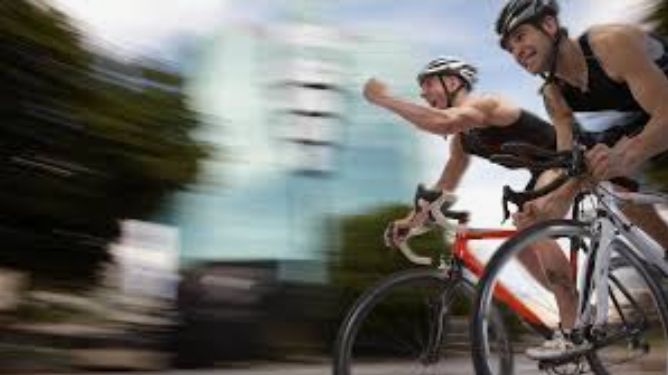Why Cycling Improves My Running
Runners consider cycling as best type of cross training because how specific it is to running, working similar muscles offering less impact than running.
Ways Riding My Bike Improves My Run
As A runner and when asking around in consideration of adding cross training to being a better, faster runner, a myriad options were suggested—ranging from a variety of non-impact exercises to strength training. I learned quickly all options are not created equal, however. When selecting the type of cross training, I needed to consider how specific the work is to running—does it work similar muscles and systems—as well as the reason for cross training—what does it offer that running doesn’t, e.g., less impact and recovery from long runs while continuing to build strength and avoid injury, And, I just can’t run more than 50 miles a week and stay healthy.
If you’re a runner, then a bike could be one of your most valuable training tools. Cycling can improve your running performance, build muscle strength and aid recovery. Discover the physical and mental benefits of cycling and why runners should give it a go.
With this in mind, cycling makes for one of the best cross training options for me. Here are reasons why cycling cross-training is best option for runners
Mimics Movement
In respect to muscle activation, the position and movement of the body while bike cross training should mimic running form as closely as possible.
Cycling out of the saddle, with the body as vertical as possible, mimics the posture of running. This is especially true in regard to the foot strike position beneath the body.
While not a bike per se, the ElliptiGO is a great exercise option that also places the body in a vertical position with the ‘foot strike’ occurring beneath me. Plus, the ElliptiGO has the additional advantage of requiring greater hip extension—the leg driving behind the torso similar to good running form—than a traditional bike.
Strengthens Calf Muscles
Running places a lot of stress on the calf muscles—especially running with a midfoot strike. When landing with a midfoot strike, the soleus (deep calf muscle) is most affected.
When cycling, the balls of the feet are placed on the center of pedal. Therefore, the contact point of the foot on the pedal is the same as the foot contact point with the road when running with a midfoot strike. This means that when pedaling—especially standing up, out of the saddle—the calves must activate to stabilize the foot on the pedal.
Strengthening the calves results in the stiffening of the calf/Achilles complex, which acts as a large source of energy while running as one of the body’s natural spring systems.
Strengthens Shin Muscles
The shin muscle (tibialis anterior) activates to pull the pedal upwards during the upstroke of the pedal stroke while in a seated position. This is most often the case when riding up a hill. To engage the tibialis anterior, I must keep my foot horizontal during the upstroke.
Since this activation during the pedaling motion strengthens the tibialis anterior, it may help to prevent muscular-based shin splints while running.
Engages the Core
A strong core is important for proper running form, as well as for decreasing the chance of injury due to mechanical compensations when other muscles have to engage to keep me upright, balanced and moving forward. To improve my core while on the bike, I need to ensure that I am using proper cycling form to engage the core, both in and out of the saddle.
—Uphill Seated Cycling Form
Cyclists with a weak or unengaged core often exhibit excessive side-to-side (tilt and rotation) movement of the upper body when riding uphill. Conversely, if my core is engaged, there should be little to no upper body movement.
To test my core engagement, I ride in the seated position up a moderately steep hill but do not grip the bars—rather, place my palms on the bar while keeping my fingers loose. This lack of support from my hands/arms will place a greater emphasis on my core. Riding uphill using this form while focusing on not bending or rotating my upper body from side-to-side will increase my core strength.
Out of the Saddle Form
Most amateur cyclists do not have proper form when riding out of the saddle. They keep the bike in a vertical position and move their body and hips up and over the bike (think: spin bike). The proper form, however, is to tilt the bike side-to-side and maintain a near motionless and upright torso position. From a performance standpoint, this allows the hips to stay in the same plane and minimizes a dead spot in the pedal stroke. From a muscle-building perspective, riding out of saddle with good form places an emphasis on the core to tilt the bike laterally, as well as to keep the body stationary and centered over the bike.
Builds the Aerobic Engine
A lot of running injuries come from overuse. Whether I’m talking about a long run or cumulative mileage, the greater the time on my feet, the greater the chance for injury. The most common reason for this is fatigue, leading to the breakdown of my running form.
Cycling, with the focus on endurance riding, allows me as a runner to get a great aerobic workout with virtually no impact on the body. As an added benefit, when going up a hill, a cyclist can shift gears to reduce or maintain their effort—an option that isn’t available to runners!
Cycling boosts anaerobic systems just as applicable to high-intensity interval-based training as it is long steady distance. Whether done outdoors or indoors on a stationary bike, doing intervals on a bike is a great way to replicate the intensity of a running workout, but without the impact.
Reduces Chance Of Injury
The problem with a run-heavy workout regimen is the risk of injury. Because the impact of running puts a lot of stress on my hips, knees and ankles, overuse injuries are fairly common.
Putting in more time on the bike counterbalances my tough run workouts, giving my body adequate time to recover before my next run. Going out for an easy spin in between running workouts can also be great for active recovery, which helps me flush out lactate, improve blood flow and reduce muscle soreness.
If I happen to get injured from running, cycling can also be used to stay in shape and helps me recover from injury without subjecting myself to the impact forces of running.
Improves My Endurance
If I’m training for a long-course run or a marathon, I’ll need to have a good endurance base to reach the finish line. While I’ll still want to include long runs into my workout routine, I might not need to do as many as I think.
Since cycling is low impact, I can spend a greater amount of time on the bike than running on the road. Long, slow rides in the 3–5 hour range can boost my endurance with minimal risk of injury, which benefits me in all areas of a half-marathon or marathon.
Another way to improve my endurance without actually logging 20-mile runs is to try the 10:1 brick workout. To complete a 10:1 brick workout, I’ll bike 10 miles for every 1 mile I run. While I’ll want to increase the length of this workout slowly, a 40-mile bike ride followed immediately with a 4-mile run provides me with a great endurance workout without completely neglecting my run. It’ll also make me more comfortable with bike-to-run transitions I may plan on in future triathalons.
Builds Complementary Muscle Strength
When I’m running, I’m building
Because running builds lean muscles, cross training is essential to improve my power and strength. While running and cycling work similar muscle groups, adding more cycling time in my weekly workouts can help address muscular imbalances and improve strength, which helps me fight fatigue in the latter stages of my race.
While my hamstrings, hip flexors and calves are major power sources for running, cycling, on the other hand, helps increase quad and gluteal strength, which can help me avoid injury and make me a faster overall runner.
Try this quick interval session to build power and strength on the bike:
- Spin easy for 10–15 minutes with a cadence above 90 rpm.
- Find a short climb that takes you about 2 minutes to reach the top. In your big chainring, complete 7–10 sprints to the top of the climb, resting for one to two minutes between each effort. Since you’ll be climbing in your big chainring, expect your cadence to be around 75 rpm.
- Cool down with an easy spin in your small chainring for 10–15 minutes with a cadence above 90 rpm.
Develop A Quicker Cadence
If there’s one similarity between world-class runners and professional cyclists, it’s a quick cadence. In fact, the best marathoners in the world generally average somewhere in the neighborhood of 170–180 steps per minute. Lance Armstrong commonly used a cadence in the 110–120 range, which only calculates the number of revolutions for one pedal during the cycling motion per minute.
Since I and some runners naturally have a longer stride and slow cadence, working on my cycling cadence helps me adopt a shorter stride with a higher turnover rate. This will help improve my speed and efficiency when I run.
Aiding Recovery
After a long run, it’s very likely my legs will be sore and the thought of going out the next day won’t fill me with joy. But a low to medium intensity bike ride the day after a long run will help my legs to recover. It’s low impact too so my joints will thank me for it.
Cycling aids recovery by increasing blood flow to my calves, quads, glutes and hamstrings, flushing out lactic acid and helping them repair. The motion itself will also reduce muscle and joint stiffness and I’ll be back out running much sooner than if I rested.
Exercising With An Injury
Getting injured is a real blow and taking a break from running can sometimes be necessary to allow my body to heal. But cycling can help me stay in shape until I am ready to run again. Even better, research shows that maintaining some activity whilst injured will reduce the time needed for recovery.
Cycling gives a great workout without the impact of a run. Although cycling long distances can cause some stress on the knees, it is comparatively far lower than running and will help me to maintain my fitness whilst putting far less stress on the body.
Finding new exhilarations
Cycling has provided me new thrills for me as a runner, offering new ways to see and experience the outdoors. Whether its mountain biking downhill, or climbing ridges to see amazing lake views in the Adirondacks.
On the bike, I try one workout per week that focuses specifically on my cadence. Using my small chainring, try to pedal at a cadence of 110 rpm or more for 5 minutes at a time. I try and complete three sets to start, eventually increasing the amount of time to make the effort more difficult.
Here are some other drills you can do to improve your pedal cadence and efficiency, which translates to your run. By adding biking into my running regimen, I am able to build fitness without wrecking my legs. This translates into bumping up not only strength, but also that anaerobic threshold, allowing me to run faster, longer, farther to some fay tackle that marathon at goal pace.
You can reach me directly at my email address anthony@anthonycrilly.com or (585)484 – 1456. Looking forward to connecting!
Best,
Anthony Crilly
Please Visit for more information: Links:





